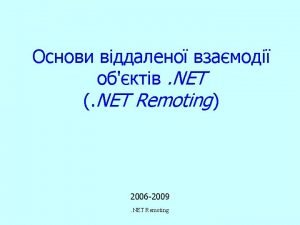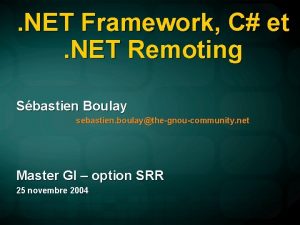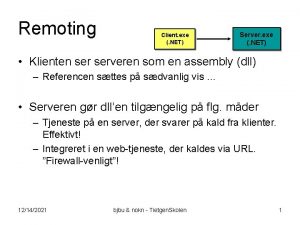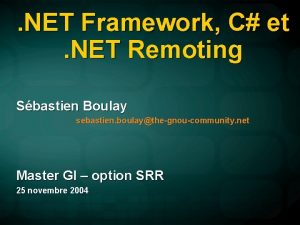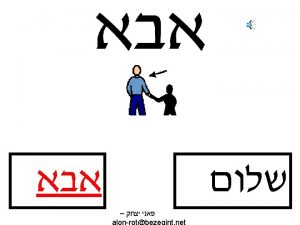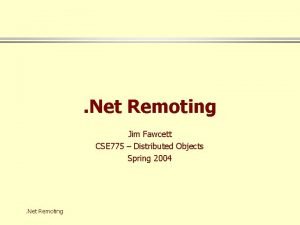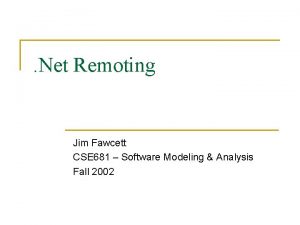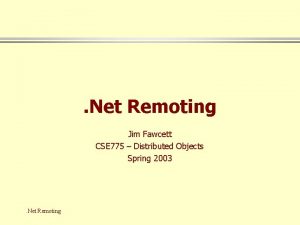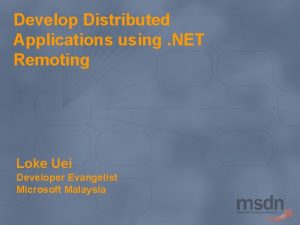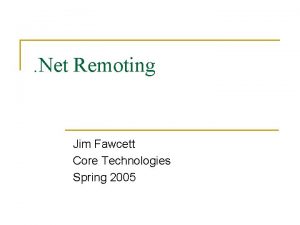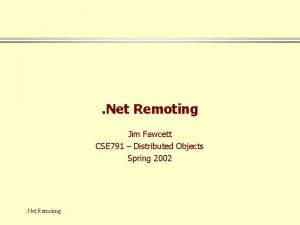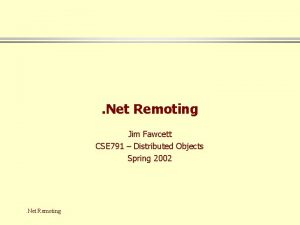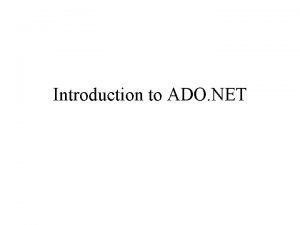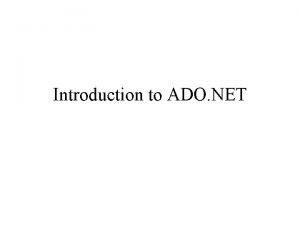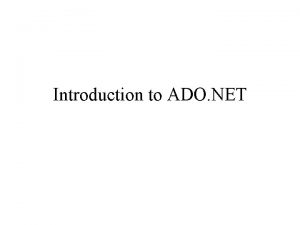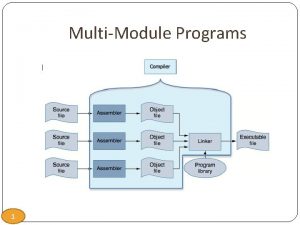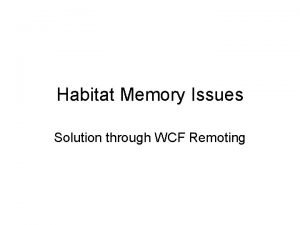NET Remoting Remoting Introduction The process of programs
















![Exposing a Server Activated Objects example class My. Application { static void Main(string[] args) Exposing a Server Activated Objects example class My. Application { static void Main(string[] args)](https://slidetodoc.com/presentation_image/45b941d3d6822a1467a8d959548d3e92/image-17.jpg)



![The Client Side public class Client { static void Main(string[] args) { // STEP The Client Side public class Client { static void Main(string[] args) { // STEP](https://slidetodoc.com/presentation_image/45b941d3d6822a1467a8d959548d3e92/image-21.jpg)













- Slides: 34

. NET Remoting

Remoting Introduction • The process of programs or components interacting across certain boundaries either different processes or machines • Developer Speak - Remoting allows you to pass objects or values across servers in different domains using several different protocols.

Remoting Benefits • Centralized Business Logic • Physical Separation of Layers • Secure Third Party Access

Why Use. NET Remoting? • Objects in different. NET application domains cannot access each other directly – two apps running on same machine even cannot talk to each other without a third party (text files, logs etc) • Enables client code in one application domain to call methods/properties of objects running in another application domain. • . NET analogy to DCOM

. NET Remoting Benefits • Multiple transfer mechanisms – HTTP/TCP – If there is no web server running – put traffic on port 80 • Multiple encodings – SOAP/ Binary (your own-serialise) • Somewhat easy configuration

. NET Remoting and DCOM • Both enable object-oriented communication between processes. • . NET Remoting has a completely different architecture. • . NET Remoting is more flexible (more activation and deployment options) • . NET Remoting is customizable (you can add logging or other features) • . NET Remoting requires more explicit client and server application configuration. DCOM simply allows you to change a registry entry. DCOM clients do not need to know the object is being remoted. • . NET Remoting has no built-in support for security.

Web Services vs. Remoting • Web Services work cross platform. • . NET Remoting is designed to work within. NET Framework. • . NET Remoting is faster (TCP is fastest) • . NET Remoting allows use of Stateful Objects • Web Services are simpler (programming-wise)

Remoting Channels • • Transfer mechanism that is used to pass calls between a client and a server There are two choices : 1. HTTP – required choice for making calls to objects hosted in IIS. 2. TCP – much faster (about 5 x)

Remoting Channels • Transport messages between boundaries • Can listen for inbound messages or send outbound messages – Or both! • . NET framework provides channel classes for TCP and HTTP remoting

TCP Remoting • System. Runtime. Remoting. Channels. Tcp • Uses a binary formatter by default • Serializes messages into binary stream for transport

HTTP Remoting • System. Runtime. Remoting. Channels. Http • Serializes messages using the SOAP-XML formatter (ascii based)

Message Formatting • TCP can be configured to transport using the SOAP formatter • HTTP can be configured to use the Binary formatter • However, the defaults are: – TCP – Binary – HTTP – SOAP/XML

Channel Classes • Tcp. Channel and Http. Channel implement the logic required for client and server sides • There are further, more specialised classes – Tcp. Server. Channel, Http. Server. Channel – Tcp. Client. Channel, Http. Client. Channel

Server Activated Objects • Is an object whose lifetime is controlled by a server • The server application makes information available and assigns it a unique name • Clients can therefore use this name to lookup and connect to the server object – This is known as a WKO – Well Known Object

Server Activated Objects Example // A sample single call Server Activated Object public class Hello : Marshal. By. Ref. Object { public String Greetings(String user) { String ret = String. Format("Hello {0} from {1}: {2}", user, App. Domain. Current. Domain. Friendly. Name, this. Get. Hash. Code()); Console. Write. Line(ret); return ret; } } • • You must inherit from Marshal. By. Ref. Object The return string is can be anything – you don’t have to use String. Format either

Exposing a Server Activated Objects • To register a WKO for remoting, a server application must do the following 1. Register at least one server-side channel 2. Register the identity (type) of remote object that will be called 3. Keep the server running/alive
![Exposing a Server Activated Objects example class My Application static void Mainstring args Exposing a Server Activated Objects example class My. Application { static void Main(string[] args)](https://slidetodoc.com/presentation_image/45b941d3d6822a1467a8d959548d3e92/image-17.jpg)
Exposing a Server Activated Objects example class My. Application { static void Main(string[] args) { // STEP 1 Channel. Services. Register. Channel( new System. Runtime. Remoting. Channels. Tcp. Server. Channel(9000)); // STEP 2 Remoting. Configuration. Register. Well. Known. Service. Type( typeof(Hello), "Greeting. Server", Well. Known. Object. Mode. Single. Call); } } // STEP 3 - keep alive Console. Write. Line("Press a key to quit"); Console. Read();

Remoting. Configuration Namespace • Just registering the channels is not enough. – All remoting types must be registered with the. NET framework as well • This is achieved via call to Register. Well. Known. Service. Type at step 2 • The Uniform Resource Locator (URI) is also supplied (“Greeting. Server”) • Now we have a server object published on a port which is referred to by its URI

The Client Side • • Before activating a remote object – a client must be used. Steps 1. Register the channel to be used via the Register. Channel method 2. Activate Remote object via Activator. Get. Object • Specifiy the type of Object required and the URL

Activator. Get. Object • A proxy is generated when this is called • Holds information required for communication to foreign resource/object – (Channel, port number, host name etc) • Proxy object is treated as if it is the remote object itself • Corresponding remote object is actually not created until first method is called
![The Client Side public class Client static void Mainstring args STEP The Client Side public class Client { static void Main(string[] args) { // STEP](https://slidetodoc.com/presentation_image/45b941d3d6822a1467a8d959548d3e92/image-21.jpg)
The Client Side public class Client { static void Main(string[] args) { // STEP 1 Channel. Services. Register. Channel( new System. Runtime. Remoting. Channels. Tcp. Client. Channel()); // STEP 2 Hello greets = (Hello)Activator. Get. Object(typeof(Hello), "tcp: //localhost: 8085/Greeting. Server"); } } String greeting = greets. Greetings("Trent"); Console. Write. Line(greeting); String greeting 2 = greets. Greetings("Janet"); Console. Write. Line(greeting 2); Console. Write. Line("End of Client");

2 Hash Codes? • This means 2 different instances of the remote type were created for each method call – ON THE SAME PROXY

Single-Call Objects • A new object is created on the server for each method call and then removed from memory after completion • What does this do to instance variables or the state of the object on the server • Answer – You can’t store anything

Singleton Objects • A remote object is created and is used for repeated method calls • Configure this on the server using Remoting. Configuration. Register. Well. Know n. Service. Type

Server Code Options Single-Call (No stored state on Server) Remoting. Configuration. Register. Well. Known. Service. Type( typeof(Hello), "Greeting. Server", Well. Known. Object. Mode. Single. Call); Singleton (Ability to store state) Remoting. Configuration. Register. Well. Known. Service. Type( typeof(Hello), "Greeting. Server", Well. Known. Object. Mode. Singleton);

Singleton Result

Singleton Considerations • Even when you store state, another client or method might change the instance variables – Leaves your object in a invalid state • Thus, it is better to implement atomic operations where possible – Client sends parameters required to server method and returns result. No other method calls are required

Required Instance Data • If you need to store instance variables then Server-Activated objects are not useful and should not really be used • Instead, Client-Activated Objects are available for this purpose

Client-Activated Objects • Lifetime is controlled by the client • Does not use Get. Object as with a client for a Server Activated object • Instead we use Activator. Create. Instance • What does this mean? – The remote object is created immediately – NOT when the first method is called – Client controls the creation of the object then

Server For A Client Activated Object class Server. For. Client. Activated. Object { static void Main(string[] args) { Channel. Services. Register. Channel(new Tcp. Server. Channel(8085)); Remoting. Configuration. Register. Activated. Service. Type(typeof(Hello)); } } // keep alive Console. Write("Key to quit"); Console. Read();

Client for Client Activated Objects class Client. For. Client. Activated. Object { static void Main(string[] args) { Channel. Services. Register. Channel( new System. Runtime. Remoting. Channels. Tcp. Client. Channel()); Hello greets = (Hello)Activator. Create. Instance( typeof(Hello), null, // params new object[] { new Url. Attribute("tcp: //localhost: 8085")}); } } String greeting = greets. Greetings("Trent"); Console. Write. Line(greeting); String greeting 2 = greets. Greetings("Janet"); Console. Write. Line(greeting 2); Console. Write. Line("End of Client");

Result of Client-Activated Objects • Object was created by client, on the server • Only one object was created (see hash code value) Server Client

Creating Proxy Classes • If a client application wants to access a remote one, the metadata (info) of that remote object must be made available – locally at the client • So far we have created clients with a local copy of the remote object we used/created • Thus, we could not create a “hello” object without having a local copy available • Sometime we cannot or should not do this, so we must create a Proxy class from the source

Configuration Files • Makes changing ports, channels, etc. much easier. • Simplifies code. • Should be named <assemblyname>. exe. config.
 Collection of programs written to service other programs.
Collection of programs written to service other programs. Hình ảnh bộ gõ cơ thể búng tay
Hình ảnh bộ gõ cơ thể búng tay Frameset trong html5
Frameset trong html5 Bổ thể
Bổ thể Tỉ lệ cơ thể trẻ em
Tỉ lệ cơ thể trẻ em Gấu đi như thế nào
Gấu đi như thế nào Chụp phim tư thế worms-breton
Chụp phim tư thế worms-breton Chúa yêu trần thế alleluia
Chúa yêu trần thế alleluia Môn thể thao bắt đầu bằng chữ đua
Môn thể thao bắt đầu bằng chữ đua Thế nào là hệ số cao nhất
Thế nào là hệ số cao nhất Các châu lục và đại dương trên thế giới
Các châu lục và đại dương trên thế giới Cong thức tính động năng
Cong thức tính động năng Trời xanh đây là của chúng ta thể thơ
Trời xanh đây là của chúng ta thể thơ Mật thư anh em như thể tay chân
Mật thư anh em như thể tay chân Làm thế nào để 102-1=99
Làm thế nào để 102-1=99 độ dài liên kết
độ dài liên kết Các châu lục và đại dương trên thế giới
Các châu lục và đại dương trên thế giới Thể thơ truyền thống
Thể thơ truyền thống Quá trình desamine hóa có thể tạo ra
Quá trình desamine hóa có thể tạo ra Một số thể thơ truyền thống
Một số thể thơ truyền thống Cái miệng xinh xinh thế chỉ nói điều hay thôi
Cái miệng xinh xinh thế chỉ nói điều hay thôi Vẽ hình chiếu vuông góc của vật thể sau
Vẽ hình chiếu vuông góc của vật thể sau Biện pháp chống mỏi cơ
Biện pháp chống mỏi cơ đặc điểm cơ thể của người tối cổ
đặc điểm cơ thể của người tối cổ Ví dụ về giọng cùng tên
Ví dụ về giọng cùng tên Vẽ hình chiếu đứng bằng cạnh của vật thể
Vẽ hình chiếu đứng bằng cạnh của vật thể Phối cảnh
Phối cảnh Thẻ vin
Thẻ vin đại từ thay thế
đại từ thay thế điện thế nghỉ
điện thế nghỉ Tư thế ngồi viết
Tư thế ngồi viết Diễn thế sinh thái là
Diễn thế sinh thái là Dot
Dot Số nguyên tố là gì
Số nguyên tố là gì Tư thế ngồi viết
Tư thế ngồi viết



































